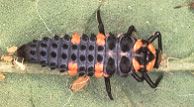

In one Ontario peach orchard study, the twospotted lady beetle, Adalia bipunctata (L.), was found to comprise 54% of all adult coccinellids, 69% of all larvae, but 100% of all fourth instars. Therefore it is one of a small number of lady beetle species to complete development in orchards; this phenomenon has been noted by European researchers as well. This species is only moderately cannibalistic, larvae are gregarious, and there is a low level dispersion of eggs by the female. The twospotted lady beetle is less likely than other coccinellids to leave the trees before the aphids have been controlled. Females possess high fecundity, averaging 30 eggs per batch. These traits combine to produce high predatory efficiency on apple aphid. The twospotted lady beetle overwinters as adults in small aggregations, averaging about 3 beetles per cluster, in tree crevices, house walls, etc. Beetles prefer south-facing walls or crevices. In spring and early summer this species prefers fruit trees; after aphids decline in midsummer, adults spread out to herbaceous hosts as well. The twospotted lady beetle is reddish with a black spot in the middle of each elytron (wing cover). The color pattern is highly variable in Europe, but not in North America. Adults have an oval shape, with the head often hidden past the eyes. The lateral edge of the pronotum (shield between the head and wings) is white. Adults are 14/100 - 1/5 inch (3.5-5.2 mm) long, and 1/10 - 16/100 inch (2.8-4.0 mm) wide.
Other common species in our area include the
ninespotted
lady beetle, Coccinella novemnotata Herbst; this species is
apparently
being displaced by an introduced European species, the sevenspotted
lady
beetle, C. septempunctata (L.). The European species is a
valuable
orchard predator in Europe; its effect in North American orchards
remains
to be seen. The former species possesses nine spots on the elytra (four
on each elytron with a spot shared near the base of the wings); the
latter
species has seven spots (three on each elytron with a shared spot). The
ninespotted lady beetle is 18/100 - 3/10 inch (4.7-7.0 mm) long, with a
rounder shape. There is white on the edge of the pronotum and a pale
band
between the eyes. This species has a round shape. The head, like that
of
the twospotted lady beetle, is largely hidden by the pronotum. The head
of the sevenspotted lady beetle is black with two separated white
spots.
Coleomegilla
maculata (DeGeer) is a smaller, narrower lady beetle [4.2-16/100 -
1/4 inch (6.6 mm) long and 1/10 - 15/100 inch (2.8-3.8 mm) wide], with
six black spots on each elytron (against a pink to red background).
This
species is highly polyphagous; in fact it is mainly a pollen feeder,
although
it will take insect prey (mites are a good food source). The convergent
lady beetle, Hippodamia convergens Guerin, is a common
coccinellid
in our area, but prefers field crops and low-growing vegetation. Its
head
is visible from above. The adult length is 16/100 - 29/100 inch
(4.2-7.3
mm) long and 1/10 - 1/5 inch (2.5-4.9 mm) wide. It has two white lines
on the pronotum converging toward the rear.